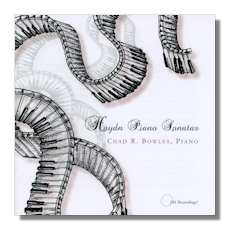
The Internet's Premier Classical Music Source
Related Links
- F.J. Haydn Reviews
- Latest Reviews
- More Reviews
-
By Composer
-
Collections
DVD & Blu-ray
Books
Concert Reviews
Articles/Interviews
Software
Audio
Search Amazon
Recommended Links
Site News
 CD Review
CD Review
Franz Joseph Haydn

Keyboard Sonatas
- Sonata in E Flat Major, Hob. XVI:49
- Sonata in B Flat Major, Hob. XVI:41
- Sonata in B minor, Hob. XVI:32
- Sonata in E Major, Hob. XVI:31
- Sonata in C Major, Hob. XVI:50
Chad R. Bowles, piano
JRI Recordings J126 72:18
Summary for the Busy Executive: The wizard.
As a really inept piano-player – I don't play well enough to deserve the title of "pianist" – I got excited when I came across a volume of Haydn's keyboard sonatas. The fast movements, of course, lay beyond the reach of my fingers, but I figured I could at least plow through the slow movements. Since I had never heard a Haydn sonata, I have no idea why I thought this, beyond perhaps a general perception of Haydn as a "simple" composer. It turned out that I could actually get through the slow movements, and this emboldened me to try some of the fast ones. The one I really liked I worked on for a year and still couldn't get through it without splonks. Then I heard over the radio a brilliant recording of the sonata by Emanuel Ax and realized I could never even approximate how the piece should go, even the slow movement. It wasn't just my cruddy technique; I didn't have the musicianship, either.
However, I did take away a new appreciation for the sonatas themselves. Like Haydn's marvelous piano trios, you don't encounter them all that much, despite a recent uptick in recordings, and they also deserve to be much better known. Chad Bowles mentions that in all his years as a student, he had only one Haydn sonata in his repertoire. The general taste for piano repertoire runs to Beethoven and beyond. You don't hear even the Mozart sonatas all that much in recital. I suspect that part of this goes back to people's view of Haydn and Mozart's idiom as "simple," which, of course, it was, compared to Liszt and Wagner. Most of the 19th century, for example, perceived Mozart as a petit maitre, a composer of, in Shaw's phrase, "tuneful little ditties." Haydn's music, of course, barely showed up on the radar, and when it did, "Papa Haydn" received the same sort of patronization, which persisted well into the 20th century.
Part of the problem with the reception of both Haydn and Mozart arose from the fact that people had forgotten how to listen to the general Classical style in which they wrote. Classicism reacted against the elaborate counterpoint and chromaticism of the late Baroque. Ironically, the Baroque had reacted in the same way against the elaborate styles of the late Renaissance and for the same reason. Both deliberately simplified the means of music in the name of greater expressivity, to clear away the frills and gewgaws of "learned" procedures and thus get closer to primary emotion. The Classical composer emphasized clarity as well as the apprehensible balance of dance. Nothing, however, remains bone-simple for long, and simplicity doesn't always mean simple-mindedness. In many ways, Haydn set himself a hard compositional task, harder than the one Liszt set for himself – to be both intelligible and interesting. Haydn's musical material is easy to digest. His treatment of this material, however, invests it with wit and depth, both of which show up in the sonatas presented here.
Like all great entertainers (he certainly qualifies), Haydn depends on having the listener follow him so that the music can pull the rug out from under. It's hard to pull off. Haydn's arsenal of tricks includes irregular phrase extensions (the number of phrase measures are no longer a multiple of two), stops and starts, arbitrary changes of key (C to G minor, rather than the usual G, for example), single notes in the melody out of key, unpredictable melodic ornamentation, single syncopated "oomphs." Haydn's sonatas, even those serious in mood, impress the listener as capricious (the elated ones come across as whimsical) and full of crotchets.
In the Sonata in C, Hob. XVI:50, we encounter many of these gags. Haydn leads off with a fragmentary idea in bare, two-part counterpoint. The exposition is nominally in C but spends most of its time in G, without the usual voice leading, subtly slipping from one to the other and back. Indeed, it seems to hover between the two keys. The development modulates all over the place. Just by listening and without a pencil and paper, I couldn't keep up and fell behind somewhere around harmonic Neptune. The second movement, an adagio, takes off from Italianate aria and reminds us of Haydn's remark that he learned about sonata form by studying opera buffa. One can imagine a diva at the footlights delivering this. In the finale, we get fragments again, this time in phrasing, rather than in the ideas. The music continually stops and restarts. It foreshadows Beethoven, although Haydn's eccentricity stays within the parameters of Classicism.
Chad R. Bowles studied with Earl Wild, among others. His ability to negotiate the fingerwork doesn't come into question. Each microquaver stands out clear and separate, even at speed, and Bowles plays these sonatas with great affection and respect. He certainly gets the wit in these scores. However, I could have used a little more poetry, which I get with Ax, among others. Bowles's attack runs to the hard, and it gets a bit wearing after a while. Effectively, Bowles highlights the martial, the clever, and the bright and blocks out the tender. Exceptions include the Adagio of the Sonata in C, where Bowles imparts a vocal quality to the melodic line. The sound is fine.
Copyright © 2011, Steve Schwartz.





















